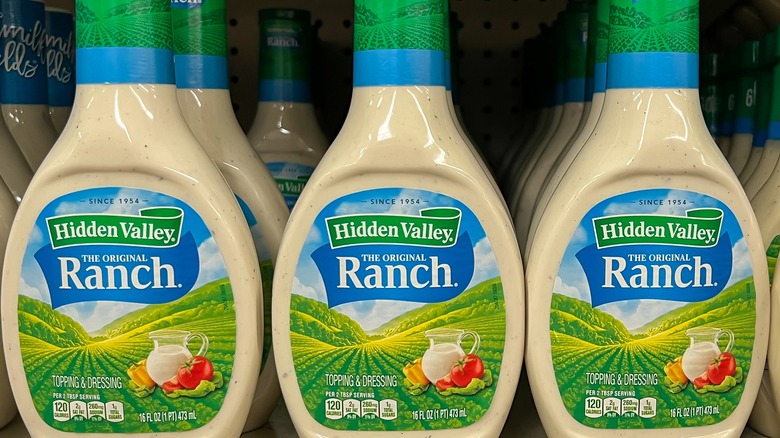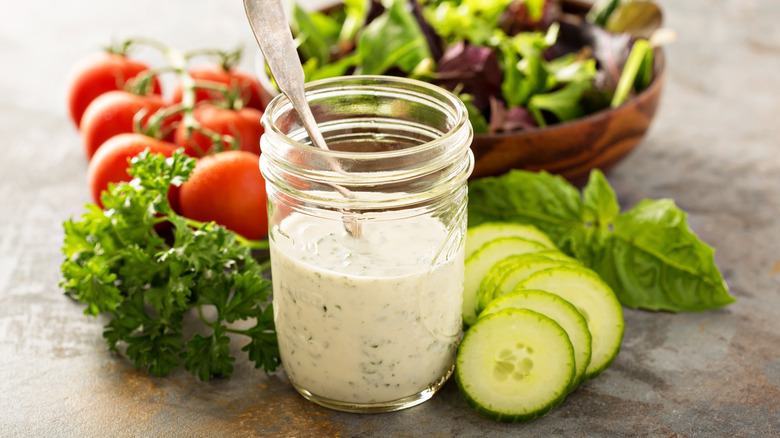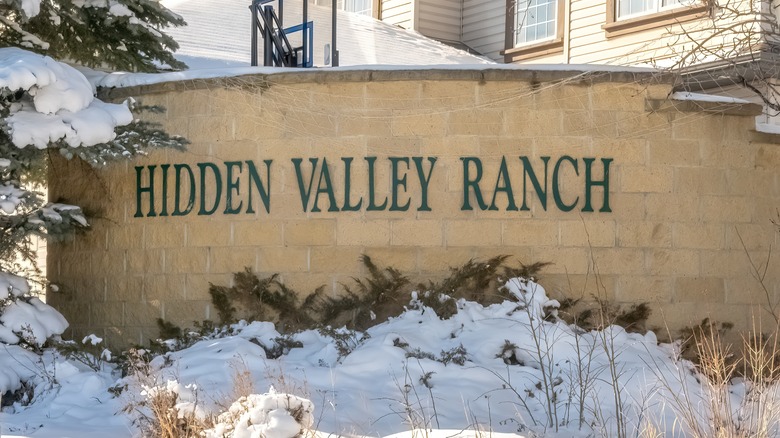Hidden Valley Ranch Was A Real Place, And It Was A Serious Hot Spot
Hidden Valley Ranch is a staple at family gatherings all across America. And whether you've used the zesty condiment as a dip for veggies, a marinade for chicken, or a dressing for salad, you know the iconic label: a magical-looking field of green, and a blue sky with fluffy clouds. It's an idyllic image, but you might be shocked to learn that there is a literal Hidden Valley Ranch — and it was a wild spot for years.
Before the condiment became famous, though, there was a man named Kenneth Henson. Henson, who went by Steve, worked as a cowboy in Nebraska before moving with his wife to Alaska. In Alaska, Steve worked for Alaskan oil companies where he was tasked with cooking for his crew. Steve got creative with the ingredients he had around him. These ingredients — mayonnaise, creamy buttermilk, and herbs and spices — eventually became Hidden Valley Ranch dressing.
But where does the literal ranch come in? After Steve left Alaska in 1956, he moved near Santa Barbara, California. He and his wife bought the Sweetwater Ranch and then renamed it — you guessed it — Hidden Valley Ranch. They hoped to transform the property into a vacation spot for outdoor types. However, that dream didn't quite pan out.
How the dressing outlived the ranch
In a letter to the Los Angeles Times from 1987, a man named Alan Barker shared his recollections of Steve and of life at Hidden Valley Ranch. "He charmed most who came to the ranch," Barker said. Kenneth Henson "opened Hidden Valley as a sort of country club, nightclub, dude ranch in the mountains ... The ranch was not received well and promptly went broke." Barker also said the ranch was often used by UCSB fraternities and sororities for parties, which definitely gives it a different vibe than the bucolic label on the bottle.
The one thing that did work, though, was that creamy salad dressing Henson concocted in Alaska. Guests loved it so much that ranch dressing seasoning packets were soon sold via mail-order. "It was all dry ingredients the way my dad made it," Steve's daughter Nola Henson told The New York Times. People would combine the dry seasoning with their own buttermilk or mayonnaise later.
In 1972, Henson sold the dressing business to Clorox for $8 million. This might sound strange — a cleaning company purchasing food products — but Clorox is actually responsible for making Hidden Valley dressing shelf-stable. In 1983, the dressing hit the shelves — and the food world has never been the same.
What happened to the ranch?
What happened to the ranch, though? That's a bit of a mystery. The ranch itself has been sold many times, including in 1992 when it went for $1.65 million. It's believed to be near San Marcos Pass, since that's where the restaurant where Kenneth Henson initially began selling his now iconic dressing is located. That restaurant, Cold Spring Tavern, is still open and, naturally, it still has ranch dressing on the menu.
Henson died in Reno in 2007 at the age of 89, but his recipe continues to bring joy to picnics, dinner parties, and snack time. Hidden Valley is an inspiration, a cultural marker, and a money maker. There have been Hidden Valley Cheez-Its, Hidden Valley Ranch chapstick (a collaboration with Burt's Bees), and even a couch designed by Dani Dazey influenced by the aesthetics of the famous dressing bottle. The couch sold for $10,000. It's safe to say the legend — and spirit — of the ranch lives on.


